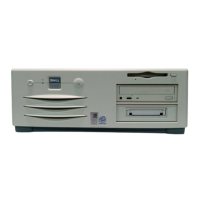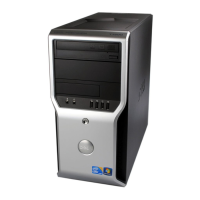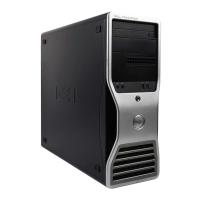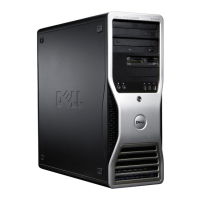Glossary: Dell Precision Workstation 470 and 670 Computers User's Guide
file:///T|/htdocs/systems/ws670/EN/ug_en/glossary.htm[3/20/2013 9:32:02 AM]
EPP — enhanced parallel port — A parallel connector design that provides bidirectional data transmission.
ESD — electrostatic discharge — A rapid discharge of static electricity. ESD can damage integrated circuits found in computer
and communications equipment.
expansion card — A circuit board that installs in an expansion slot on the system board in some computers, expanding the
capabilities of the computer. Examples include video, modem, and sound cards.
expansion slot — A connector on the system board (in some computers) where you insert an expansion card, connecting it
to the system bus.
Express Service Code — A numeric code located on a sticker on your Dell™ computer. Use the Express Service Code when
contacting Dell for assistance. Express Service Code service may not be available in some countries.
extended display mode — A display setting that allows you to use a second monitor as an extension of your display. Also
referred to as dual display mode.
extended PC Card — A PC Card that extends beyond the edge of the PC Card slot when installed.
F
Fahrenheit — A temperature measurement system where 32° is the freezing point and 212° is the boiling point of water.
failed — State of nonredundant array that has suffered a single drive failure, or a redundant array that has suffered multiple
drive failures. A failed array is inaccessible and data is lost.
fault-tolerant array — Refers to an array that can continue to function after a disk drive failure without loss of data. Fault
tolerant, or redundant arrays, include RAID 1 and RAID 10 arrays.
FCC — Federal Communications Commission — A U.S. agency responsible for enforcing communications-related regulations
that state how much radiation computers and other electronic equipment can emit.
floppy drive — A disk drive that can read and write to floppy disks.
folder — A term used to describe space on a disk or drive where files are organized and grouped. Files in a folder can be
viewed and ordered in various ways, such as alphabetically, by date, and by size.
format — The process that prepares a drive or disk for file storage. When a drive or disk is formatted, the existing
information on it is lost.
FSB — front side bus — The data path and physical interface between the processor and RAM.
FTP — file transfer protocol — A standard Internet protocol used to exchange files between computers connected to the
Internet.
G
G — gravity — A measurement of weight and force.
GB — gigabyte — A measurement of data storage that equals 1024 MB (1,073,741,824 bytes). When used to refer to hard
drive storage, the term is often rounded to 1,000,000,000 bytes.
GHz — gigahertz — A measurement of frequency that equals one thousand million Hz, or one thousand MHz. The speeds for
computer processors, buses, and interfaces are often measured in GHz.
graphics mode — A video mode that can be defined as x horizontal pixels by y vertical pixels by z colors. Graphics modes
can display an unlimited variety of shapes and fonts.
GUI — graphical user interface — Software that interacts with the user by means of menus, windows, and icons. Most
programs that operate on the Windows operating systems are GUIs.
H

